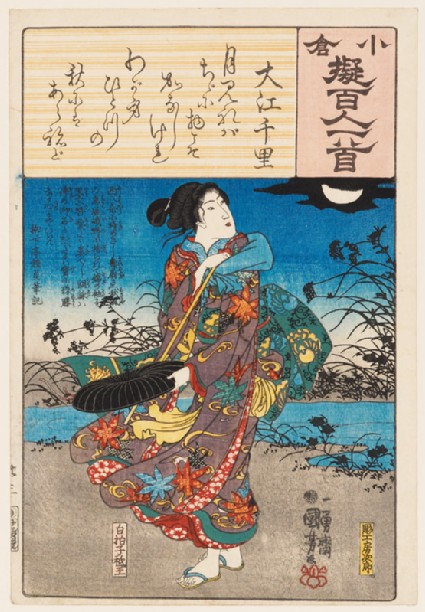Browse: 10610 objects
- Reference URL
Actions
Ōe no Chisato
-
Description
Each print in this series illustrates a poem from a famous 13th-century poetry anthology with a scene from Japanese history or legend. Begun during the repressive Tenpō Reforms of the mid-1830s, the series includes many surreptitious portraits of popular actors. This print shows the dancer Giō, favourite of the tyrant Taira no Kiyomori. One day Kiyomori replaced her with another dancer, Hotoke. Devastated, Giō became a nun. Years later, Hotoke visited Giō’s humble house deep in the countryside to ask her forgiveness. Here, Giō recalls the sadness both women have endured, an emotion expressed in the poem above.
-
Details
- Series
- Take-offs Based on the Ogura Version of the ‘One Hundred Poems by One Hundred Poets’
- Associated place
- Date
- 1845 - 1847
- Artist/maker
-
Utagawa Kuniyoshi (1797 - 1861) (designer)Matsushima Fusajirō (active mid-19th century) (block cutter)Ōe no Chisato (active c. 9th century AD) (author)
- Associated people
-
Ibaya Senzaburō (active c. 1820s - c. 1870s) (publisher)Kinugasa Fusajirō (active c. 1843 - 1853) (censor)
- Material and technique
- nishiki-e (multi-block) woodblock print, with bokashi (tonal gradation)
- Dimensions
-
mount 55.5 x 40.2 cm (height x width)
print 35.3 x 24.1 cm (height x width)
- Material index
- Technique index
- Object type index
- No. of items
- 1
- Credit line
- Presented by George Grigs, Miss Elizabeth Grigs, and Miss Susan Messer, in memory of Derick Grigs, 1971.
- Accession no.
- EA1971.125
Glossary
nishiki-e
-
nishiki-e
Nishiki-e literally means 'brocade pictures' and refers to multi-coloured woodblock prints.
Location
-
- currently in research collection
Objects are sometimes moved to a different location. Our object location data is usually updated on a monthly basis. Contact the Jameel Study Centre if you are planning to visit the museum to see a particular object on display, or would like to arrange an appointment to see an object in our reserve collections.
© 2013 University of Oxford - Ashmolean Museum

